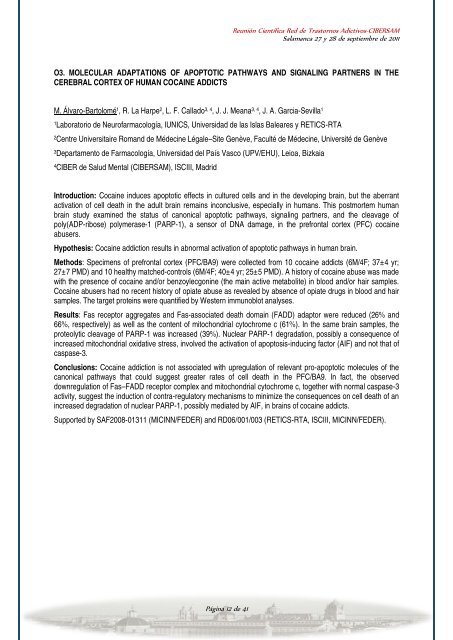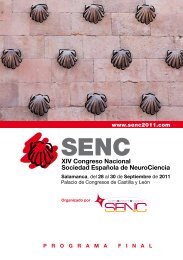Reunión Científica Red <strong>de</strong> Trastornos Adictivos-CIBERSAMSa<strong>la</strong>manca 27 y 28 <strong>de</strong> septiembre <strong>de</strong> 2011O3. MOLECULAR ADAPTATIONS OF APOPTOTIC PATHWAYS AND SIGNALING PARTNERS IN THECEREBRAL CORTEX OF HUMAN COCAINE ADDICTSM. Álvaro-Bartolomé 1 , R. La Harpe 2 , L. F. Cal<strong>la</strong>do 3, 4 , J. J. Meana 3, 4 , J. A. Garcia-Sevil<strong>la</strong> 11Laboratorio <strong>de</strong> Neurofarmacología, IUNICS, Universidad <strong>de</strong> <strong>la</strong>s Is<strong>la</strong>s Baleares y RETICS-RTA2Centre Universitaire Romand <strong>de</strong> Mé<strong>de</strong>cine Légale–Site Genève, Faculté <strong>de</strong> Mé<strong>de</strong>cine, Université <strong>de</strong> Genève3Departamento <strong>de</strong> Farmacología, Universidad <strong>de</strong>l País Vasco (UPV/EHU), Leioa, Bizkaia4CIBER <strong>de</strong> Salud Mental (CIBERSAM), ISCIII, MadridIntroduction: Cocaine induces apoptotic effects in cultured cells and in the <strong>de</strong>veloping brain, but the aberrantactivation of cell <strong>de</strong>ath in the adult brain remains inconclusive, especially in humans. This postmortem humanbrain study examined the status of canonical apoptotic pathways, signaling partners, and the cleavage ofpoly(ADP-ribose) polymerase-1 (PARP-1), a sensor of DNA damage, in the prefrontal cortex (PFC) cocaineabusers.Hypothesis: Cocaine addiction results in abnormal activation of apoptotic pathways in human brain.Methods: Specimens of prefrontal cortex (PFC/BA9) were collected from 10 cocaine addicts (6M/4F; 37±4 yr;27±7 PMD) and 10 healthy matched-controls (6M/4F; 40±4 yr; 25±5 PMD). A history of cocaine abuse was ma<strong>de</strong>with the presence of cocaine and/or benzoylecgonine (the main active metabolite) in blood and/or hair samples.Cocaine abusers had no recent history of opiate abuse as revealed by absence of opiate drugs in blood and hairsamples. The target proteins were quantified by Western immunoblot analyses.Results: Fas receptor aggregates and Fas-associated <strong>de</strong>ath domain (FADD) adaptor were reduced (26% and66%, respectively) as well as the content of mitochondrial cytochrome c (61%). In the same brain samples, theproteolytic cleavage of PARP-1 was increased (39%). Nuclear PARP-1 <strong>de</strong>gradation, possibly a consequence ofincreased mitochondrial oxidative stress, involved the activation of apoptosis-inducing factor (AIF) and not that ofcaspase-3.Conclusions: Cocaine addiction is not associated with upregu<strong>la</strong>tion of relevant pro-apoptotic molecules of thecanonical pathways that could suggest greater rates of cell <strong>de</strong>ath in the PFC/BA9. In fact, the observeddownregu<strong>la</strong>tion of Fas–FADD receptor complex and mitochondrial cytochrome c, together with normal caspase-3activity, suggest the induction of contra-regu<strong>la</strong>tory mechanisms to minimize the consequences on cell <strong>de</strong>ath of anincreased <strong>de</strong>gradation of nuclear PARP-1, possibly mediated by AIF, in brains of cocaine addicts.Supported by SAF2008-01311 (MICINN/FEDER) and RD06/001/003 (RETICS-RTA, ISCIII, MICINN/FEDER).Página 12 <strong>de</strong> 41
Reunión Científica Red <strong>de</strong> Trastornos Adictivos-CIBERSAMSa<strong>la</strong>manca 27 y 28 <strong>de</strong> septiembre <strong>de</strong> 2011O4. Estudio <strong>de</strong> información y prevención sobre drogas emergentes: Proyecto ReDNet (RecreationalDrugs European Network).F. Marsà Sambo<strong>la</strong> 1 , M. Torrens Mèlich 2,3 , M. Farré Alba<strong>la</strong><strong>de</strong>jo 1,3 y ReDNet group 4 .1Unidad <strong>de</strong> Farmacología Humana, Programa <strong>de</strong> Neurociencias, Institut <strong>de</strong> Investigación- Hospital <strong>de</strong>l Mar(IMIM), RTA, Barcelona.2Instituto <strong>de</strong> Neuropsiquiatria y Adicciones-Parc <strong>de</strong> Salut Mar, Programa <strong>de</strong> Neurociencias, Instituto <strong>de</strong>Investigación- Hospital <strong>de</strong>l Mar (IMIM), RTA, Barcelona.3Facultad <strong>de</strong> Medicina, Universitat Autònoma <strong>de</strong> Barcelona, Barcelona4ReDNet Group (O. Corazza, Z. Davey, P. De Luca, Z. Demetrovics, A. Enea, G. di Melchiorre, L. Di Furia, L.Fles<strong>la</strong>nd, N. Scherbaum5, H. Siemann, A. Skutle, M. Torrens, M. Pasinetti, C. Pezzolesi, H. Shapiro, E.Sferrazza, P. van <strong>de</strong>r Kreeft y F.Schifano.)Objetivo: La influencia <strong>de</strong> <strong>la</strong>s nuevas tecnologías provoca cambios en <strong>la</strong> aparición y consumo <strong>de</strong> nuevasdrogas. A raíz <strong>de</strong> este fenómeno, surge el proyecto europeo RedNet <strong>de</strong>sarrol<strong>la</strong>do en ocho países (Reino Unido,Polonia, España, Italia, Hungría, Bélgica, Noruega y Alemania) con el objetivo <strong>de</strong> mejorar el conocimiento <strong>de</strong> <strong>la</strong>sdrogas emergentes (legal highs) para disminuir el riesgo asociado al consumo.Material y Método: El ReDNet está estructurado en dos fases. 1) Evaluación <strong>de</strong>l grado <strong>de</strong> información actual y<strong>de</strong> nuevos aspectos a incluir en <strong>la</strong> información sobre <strong>la</strong>s drogas emergentes mediante encuestas a profesionales<strong>de</strong> <strong>la</strong> salud y a jóvenes <strong>de</strong> 16 a 24 años. 2) Creación <strong>de</strong> instrumentos <strong>de</strong> prevención a partir <strong>de</strong> distintasTecnologías <strong>de</strong> <strong>la</strong> Información y <strong>de</strong> <strong>la</strong> comunicación (TIC’s).Resultados:Presentamos resultados preliminares <strong>de</strong> <strong>la</strong> primera fase <strong>de</strong>l estudio en España. Se han realizado 100 encuestasa profesionales, con una edad media <strong>de</strong> 38 años, mujeres (64%), psiquiatras (36%), con media <strong>de</strong> 8 años <strong>de</strong>experiencia. Las drogas emergentes más conocidas por los profesionales son el GBL (gamma-butiro<strong>la</strong>ctona), elGHB (ácido gamma-hidroxibutírico) y el 1,4-Butandiol (34% -muy conocido-), seguida <strong>de</strong> <strong>la</strong> Mefedrona (23%-medianamente conocida-) y el NRG-1(Nafirona) (94%-poco conocido-).Los principales aspectos a incluir en <strong>la</strong> mejoría <strong>de</strong>l conocimiento <strong>de</strong> <strong>la</strong>s drogas emergentes son <strong>la</strong>s alteracionespsicopatológicas (71%), el síndrome <strong>de</strong> abstinencia (64%) y los efectos psicoactivos <strong>de</strong>seados (59%). La TICmás solicitada para obtener <strong>la</strong> información ha sido el listado <strong>de</strong> webs que <strong>de</strong>n información sobre <strong>la</strong>s drogasemergentes (52%).ConclusionesLos resultados <strong>de</strong> este estudio servirán para facilitar el acceso a información actualizada <strong>de</strong> <strong>la</strong>s drogasemergentes, a los profesionales <strong>de</strong> <strong>la</strong> salud que trabajan en el área <strong>de</strong> <strong>la</strong>s adicciones.Agra<strong>de</strong>cimientos. El proyecto ReDNet está financiado por <strong>la</strong> European Comission Executive Agency for Healthand Consumers (2009 12 16) y <strong>la</strong> Red <strong>de</strong> Trastornos Adictivos (RD06/0001/1009).Áreas Temáticas:1ª: Nuevos métodos y tecnologías.2ª: Neurociencia cognitiva y conductual.Ferran Marsà Sambo<strong>la</strong>: fmarsa@imim.esPágina 13 <strong>de</strong> 41




